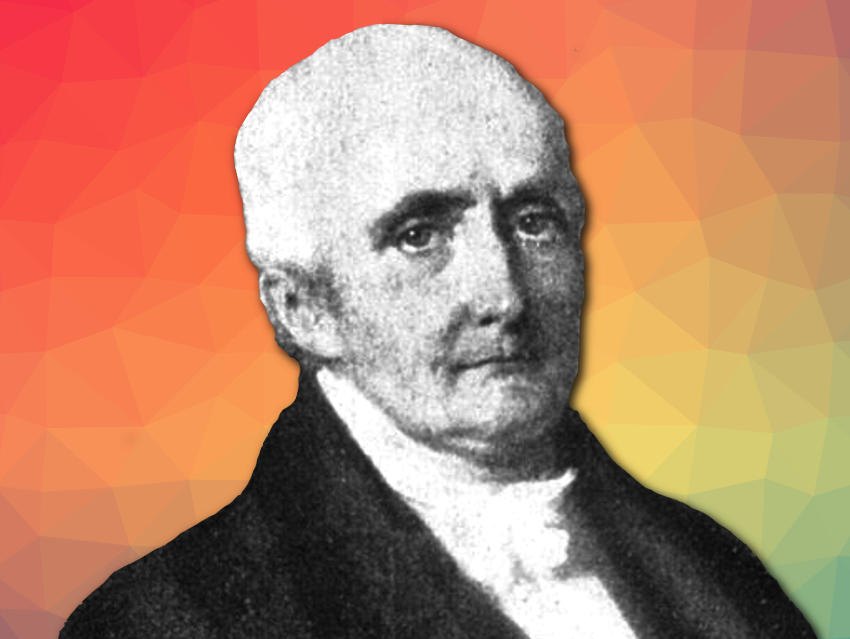Nicolas-Théodore de Saussure was born in Geneva, Switzerland, on October 14, 1767, into a wealthy family with many natural scientists. From 1782 to 1786, he studied math, science, and history at l’académie de Genève. He traveled to London, UK (1873/74), and Paris to meet scientists and take chemistry courses. In 1802, he became an Honorary Professor of mineralogy and geology at the University of Geneva. He remained on the faculty until 1835 and did research in his private laboratory [1].
In 1815, Nicolas-Théodore de Saussure was one of the founding members of Société Helvétique des Sciences Naturelles (Swiss Academy of Natural Sciences). He died in Geneva on April 18, 1845.
Boyle’s Law
Nicolas-Théodore de Saussure accompanied his father on his Alpine expeditions, to helped him with experiments in physics, chemistry, mineralogy, and meteorology. At the age of 20, Nicolas-Théodore confirmed Boyle’s law (p1V1 = p2V2) during an ascent of Mont Blanc using a new method. He weighed a tightly closed piston at many different heights and found that the differences in weight were exactly proportional to the differences in barometric pressure readings.
In March 1792, he performed a chemical analysis of the calcium magnesium carbonate mineral that Déodat Gratet de Dolomieu had discovered in 1791. De Saussure named it dolomite after him.
Photosynthesis [2,3,4,5]
Théodore de Saussure’s greatest contribution to science was his research on photosynthesis published in 1804. It was the first summation of the fundamental process of photosynthesis and a major contribution to the understanding of plant physiology. De Saussure was the first to formulate a kind of cycle of two biological processes: photosynthesis and respiration.
Plants absorb carbon dioxide and release oxygen when exposed to light. However, they also release carbon dioxide during respiration. He showed experimentally that the increase in the mass of a plant during its growth is not only due to the absorption of CO2 but also to the incorporation of water. He demonstrated that plants obtain their carbon from the carbon dioxide in the atmosphere and not, as his predecessors had generally believed, by the absorption of humus from the soil. He also showed that plants take up mineral nutrients from the soil. However, he was unable to definitively identify the source of plant nitrogen in the soil.
Saussure is considered the last of the early pioneers of photosynthesis research, completing the work begun by his predecessors, including Jan Baptist van Helmont, Joseph Priestley, Jan Ingenhousz, and Jean Senebier. Justus von Liebig re-discovered and revived the findings of Saussure [6].
Advances in Many Other Fields
Anethole or anise camphor is an aromatic compound that is widely found in nature in essential oils and contributes to the smell and taste of anise and fennel, for example. It was first chemically investigated in 1820 by Nicolas-Théodore de Saussure. In addition, he made important advances in various fields. He determined the composition of alcohol and ether, studied the conversion of starches into sugars [7], analyzed the composition and properties of naphtha [8], and investigated fermentation, to name a few.
References
[1] Jaime Wisniak, Nicolas Théodore Saussure: Contributions to chemistry and physical chemistry, Rev. CENIC Cienc. Quim. 2018, 49, 1–17.
[2] Theodor von Saussüre, Chemische Untersuchungen über die Vegetation, Annalen der Chemie 1804. https://doi.org/10.1002/andp.18040181006
[3] Theodor von Saussüre, Chemische Untersuchungen über die Vegetation, Annalen der Physik 1804. https://doi.org/10.1002/andp.18040181006
[4] Theodor de Saussure, Ueber die Ernährung der Pflanzen, Justus Liebigs Annalen der Chemie 1842, https://doi.org/10.1002/jlac.18420420306
[5] Sabine Streller, Klaus Roth, Mein Kleiner Grüner Kaktus, Chem. Unserer Zeit 2010, 44, 284 – 305. https://doi.org/10.1002/ciuz.201000536
[6] Justus Liebig, Bemerkungen zu vorstehenden Versuchen de Saussure’s, Justus Liebigs Annalen der Chemie 1842. https://doi.org/10.1002/jlac.18420420307
[7] Theodor von Saussure, Ueber die Verwandlung von Stärke in Zucker, Annalen der Physik 1815. https://doi.org/10.1002/andp.18150490107
[8] Theodor von Saussure, Zusammensetzung und Eigenschaften der Naphtha, untersucht an der von Miano, Annalen der Physik 1818. https://doi.org/10.1002/andp.18180601103



